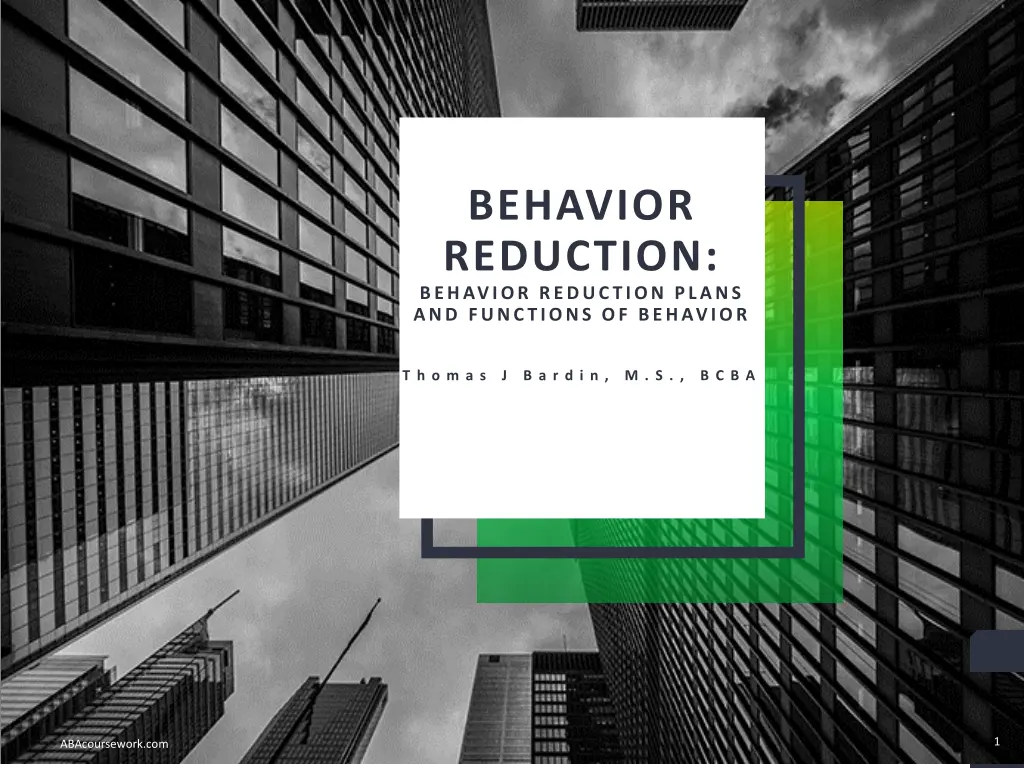
Effective Behavior Reduction Strategies
Learn about behavior reduction plans, how to identify essential components, and implement crisis/emergency procedures in this informative guide. Understand the functions of behavior and the importance of a Functional Behavior Assessment (FBA) in creating effective plans.
Download Presentation

Please find below an Image/Link to download the presentation.
The content on the website is provided AS IS for your information and personal use only. It may not be sold, licensed, or shared on other websites without obtaining consent from the author. If you encounter any issues during the download, it is possible that the publisher has removed the file from their server.
You are allowed to download the files provided on this website for personal or commercial use, subject to the condition that they are used lawfully. All files are the property of their respective owners.
The content on the website is provided AS IS for your information and personal use only. It may not be sold, licensed, or shared on other websites without obtaining consent from the author.
E N D
Presentation Transcript
BEHAVIOR REDUCTION: BEHAVIOR REDUCTION PLANS AND FUNCTIONS OF BEHAVIOR T h o m a s J B a r d i n , M . S . , B C B A 1 ABAcoursework.com
WHY DO THEY DO THAT? BEHAVIOR REDUCTION PLANS AND FUNCTIONS OF BEHAVIOR 40 Hour RBT Course
D-1 Identify essential components of a written behavior reduction plan OBJECTIVE
BEHAVIOR REDUCTION PLANS Operational definitions of target behaviors Antecedent modifications Replacement behaviors Consequence modifications Persons responsible Emergency measures Function of behavior
A Behavior Reduction plan requires a Functional Behavior Assessment or FBA THUS So what functions are there to look for? We ll get there in a moment, but first
D-06: IMPLEMENT CRISIS/EMERGENCY PROCEDURES ACCORDING TO PROTOCOL Will differ for each client but you should look for and be familiar with Will differ for each client but you should look for and be familiar with the following: the following: Emergency contact information Emergency contact information Emergency service numbers (police, fire department, EMS) Emergency service numbers (police, fire department, EMS) Medical information. i.e. Epilepsy is common in the ASD population and Medical information. i.e. Epilepsy is common in the ASD population and you should know how to respond in case of a seizure. you should know how to respond in case of a seizure. Neglect and abuse reporting: you are most likely a mandated reporter. Neglect and abuse reporting: you are most likely a mandated reporter. How to react to maladaptive behaviors from the client: How to react to maladaptive behaviors from the client: Aggression toward you, peers, other adults, all three groups Aggression toward you, peers, other adults, all three groups Elopement Elopement Property Destruction Property Destruction
Escape/avoidance I don t want to do this FOUR WHYS FUNCTIONS Attention seeking Look at me look at me! Access to tangible I want that! Automatically reinforcing OF This feels good when I do this BEHAVIOR
ESCAPE/AVOIDANCE (I DON T WANT TO DO THAT) Food they don t want to eat Things they don t understand Difficult activities Things that feel uncomfortable Overwhelming activities
ESCAPE/AVOIDANCE (I DONT ESCAPE/AVOIDANCE (I DON T WANT TO DO THAT) WANT TO DO THAT) Examples Laughing every time someone tries to feed them food they don t like Running away when told to make eye contact or say something Throwing toys when told to clean up Throwing tantrums when told to get dressed or get ready to leave
ATTENTION (LOOK AT ME LOOK AT ME) Laughing loudly or making repetitive noises Hitting Tripping over toys or falling down a lot Crying Throwing food or toys
ACCESS Hitting when an activity is terminated TO Crying when told to clean up TANGIBLE (I WANT THAT) Crying when a toy or activity is removed Crying when denied hug or kiss Crying when told to wait for something
AUTOMATICALLY REINFORCING (THIS FEELS GOOD WHEN I DO IT) Scratches a spot repetitively Engages in a behavior when no one is around Says the same thing over and over Shakes objects in front of their face
ASR Monique throws an average of two tantrums per/day at school. The tantrums last a total of 34 minutes and usually occur before math or writing assignments. What is the function of Monique s tantrums?
ASR Monique throws an average of two tantrums per/day at school. The tantrums last a total of 34 minutes and usually occur before math or writing assignments. What measurement procedures are used?
ASR What additional information would you need to make a hypothesis about the function of Monique s behavior?
REFERENCES Behavior Analyst Certification Board. (2014). Applied Behavior Analysis Treatment of Autism Spectrum Disorder: Practice Guidelines for Healthcare Funders and Managers. Cooper, John O., Heron, Timothy E. Heward, William L.. (2007) Applied behavior analysis / Upper Saddle River, N.J. : Pearson/Merrill-Prentice Hall Tarbox, J. & Tarbox, C. (2017). Training Manual for Behavior Technicians Working with Individuals with Autism.
